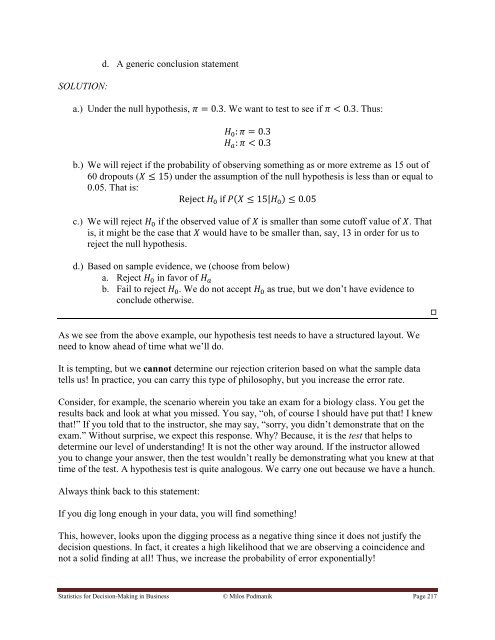Statistics for Decision- Making in Business - Maricopa Community ...
Statistics for Decision- Making in Business - Maricopa Community ...
Statistics for Decision- Making in Business - Maricopa Community ...
Create successful ePaper yourself
Turn your PDF publications into a flip-book with our unique Google optimized e-Paper software.
SOLUTION:<br />
d. A generic conclusion statement<br />
a.) Under the null hypothesis, . We want to test to see if . Thus:<br />
b.) We will reject if the probability of observ<strong>in</strong>g someth<strong>in</strong>g as or more extreme as 15 out of<br />
60 dropouts ( ) under the assumption of the null hypothesis is less than or equal to<br />
0.05. That is:<br />
( )<br />
c.) We will reject if the observed value of is smaller than some cutoff value of . That<br />
is, it might be the case that would have to be smaller than, say, 13 <strong>in</strong> order <strong>for</strong> us to<br />
reject the null hypothesis.<br />
d.) Based on sample evidence, we (choose from below)<br />
a. Reject <strong>in</strong> favor of<br />
b. Fail to reject . We do not accept as true, but we don‟t have evidence to<br />
conclude otherwise.<br />
As we see from the above example, our hypothesis test needs to have a structured layout. We<br />
need to know ahead of time what we‟ll do.<br />
It is tempt<strong>in</strong>g, but we cannot determ<strong>in</strong>e our rejection criterion based on what the sample data<br />
tells us! In practice, you can carry this type of philosophy, but you <strong>in</strong>crease the error rate.<br />
Consider, <strong>for</strong> example, the scenario where<strong>in</strong> you take an exam <strong>for</strong> a biology class. You get the<br />
results back and look at what you missed. You say, “oh, of course I should have put that! I knew<br />
that!” If you told that to the <strong>in</strong>structor, she may say, “sorry, you didn‟t demonstrate that on the<br />
exam.” Without surprise, we expect this response. Why Because, it is the test that helps to<br />
determ<strong>in</strong>e our level of understand<strong>in</strong>g! It is not the other way around. If the <strong>in</strong>structor allowed<br />
you to change your answer, then the test wouldn‟t really be demonstrat<strong>in</strong>g what you knew at that<br />
time of the test. A hypothesis test is quite analogous. We carry one out because we have a hunch.<br />
Always th<strong>in</strong>k back to this statement:<br />
If you dig long enough <strong>in</strong> your data, you will f<strong>in</strong>d someth<strong>in</strong>g!<br />
This, however, looks upon the digg<strong>in</strong>g process as a negative th<strong>in</strong>g s<strong>in</strong>ce it does not justify the<br />
decision questions. In fact, it creates a high likelihood that we are observ<strong>in</strong>g a co<strong>in</strong>cidence and<br />
not a solid f<strong>in</strong>d<strong>in</strong>g at all! Thus, we <strong>in</strong>crease the probability of error exponentially!<br />
<strong>Statistics</strong> <strong>for</strong> <strong>Decision</strong>-<strong>Mak<strong>in</strong>g</strong> <strong>in</strong> Bus<strong>in</strong>ess © Milos Podmanik Page 217
















